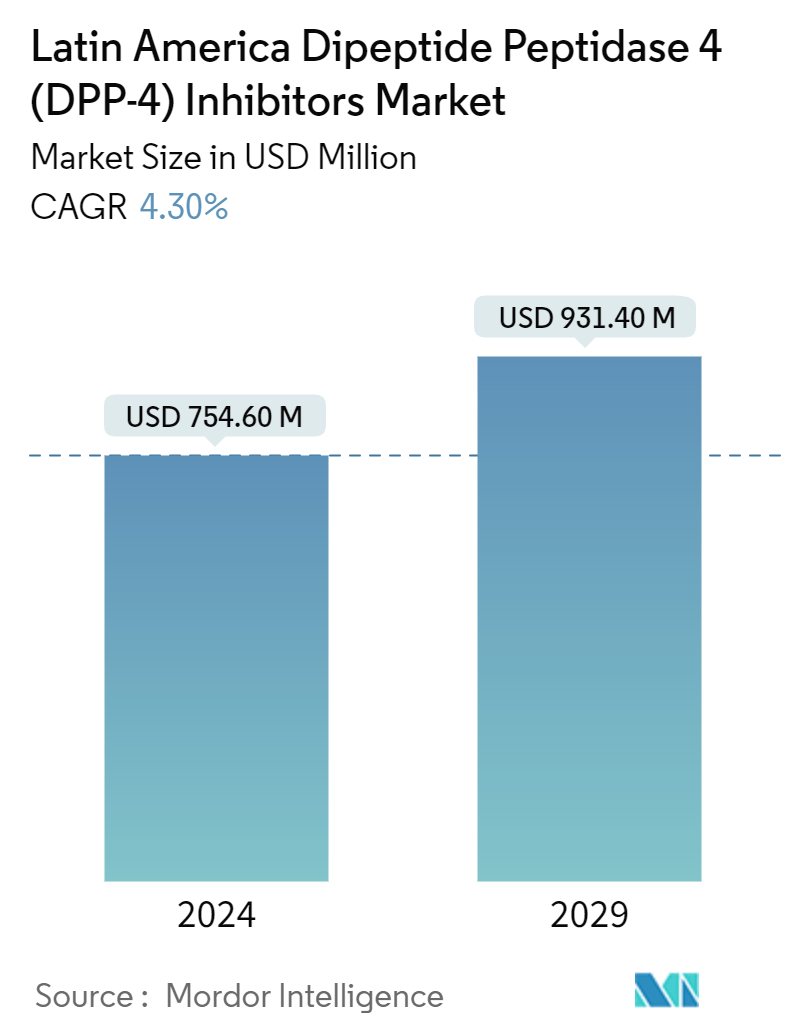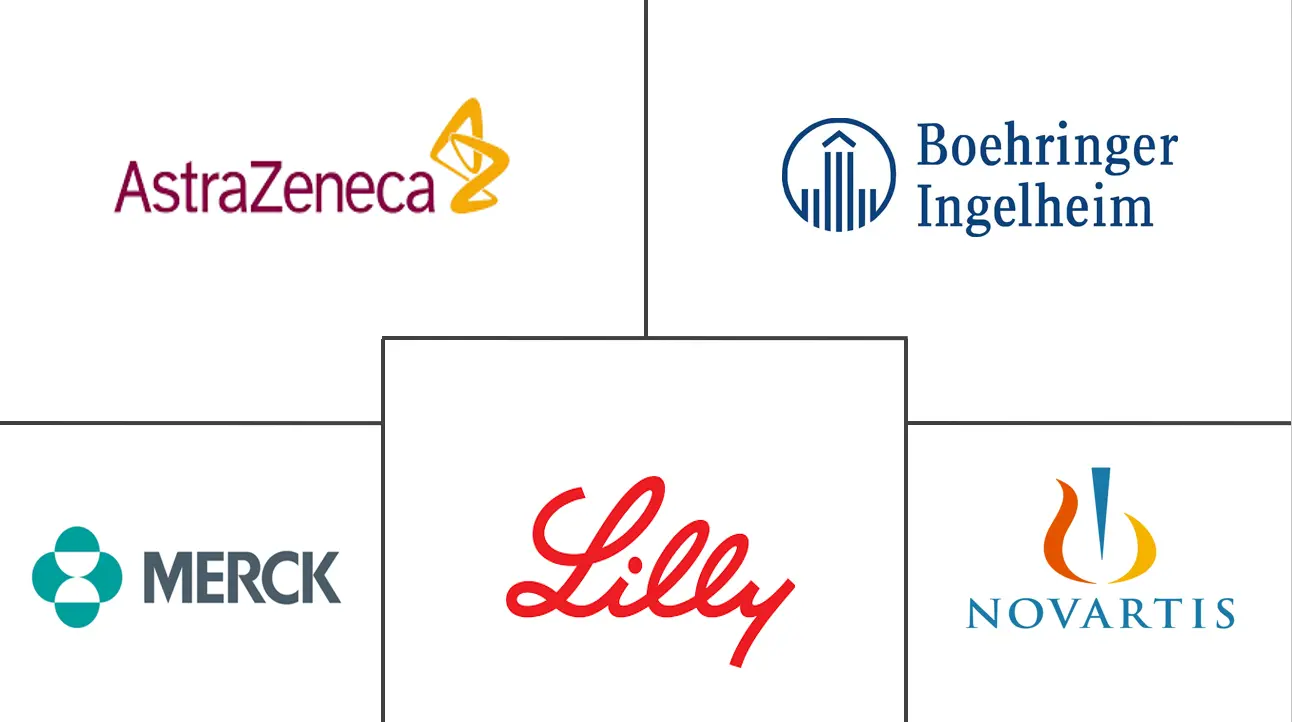Market Size of Latin America Dipeptide Peptidase 4 (DPP-4) Inhibitors Industry

| Study Period | 2019 - 2029 |
| Base Year For Estimation | 2023 |
| Forecast Data Period | 2024 - 2029 |
| Historical Data Period | 2019 - 2022 |
| Market Size (2024) | USD 754.60 Million |
| Market Size (2029) | USD 931.40 Million |
| CAGR (2024 - 2029) | 4.30 % |
Major Players
*Disclaimer: Major Players sorted in no particular order |
Latin America DPP-4 Inhibitors Market Analysis
The Latin America Dipeptide Peptidase 4 Inhibitors Market size is estimated at USD 754.60 million in 2024, and is expected to reach USD 931.40 million by 2029, growing at a CAGR of 4.30% during the forecast period (2024-2029).
Dipeptidyl peptidase 4 (DPP-4) inhibitors are a class of medicine that lower high blood glucose levels and are used in the treatment of type 2 diabetes. DPP4 inhibitors increase insulin and GLP-1 secretion and are commonly prescribed for people suffering from type 2 diabetes. The use of DPP4 inhibitors in patients with COVID-19 with or even without type 2 diabetes offers a simple way to reduce the virus entry and replication into the airways and to hamper the sustained cytokine storm and inflammation within the lung in patients diagnosed with COVID-19 infection.
The diabetic prevalence is high in countries in the Latin American region, and Mexico is known to have a high number of diabetic patients due to the growing prevalence of Type-2 diabetes in the country. The gradually growing obesity rate, combined with the genetic predisposition for Type-2 diabetes, acted as a prominent driver for the increase in the Type-2 diabetic population over the last 40 years. Currently, nearly 10% of the population is living with diabetes. Diabetic patients in the Latin American region mainly suffer from Type-2 diabetes, accounting for nearly 90% of the total diabetic population.
Mexico has multiple health insurance providers. The Instituto de Seguridad y Servicios Sociales de los Trabajadores del Estado (State Employee's Social Security and Social Services Institute, ISSSTE) provides coverage for government employees, and the Instituto Mexicano del Seguro Social (Mexican Social Security Institute, IMSS) covers private-sector employees. The Seguro Popular (People's Insurance) was launched to protect the working-age population against steep healthcare costs.
Therefore, owing to the aforementioned factors the studied market is anticipated to witness growth over the analysis period.
Latin America DPP-4 Inhibitors Industry Segmentation
Dipeptidyl peptidase 4 (DPP-4) inhibitors are a pharmacological class of drugs for treating type-2 diabetes. They help to control glycemia by increasing the levels of active incretins. The Latin America Dipeptide Peptidase 4 (DPP-4) Inhibitors Market is segmented by drugs, brands and Geography. The report offers the value (in USD) and volume (in units) for the above segments.
| Drugs | |
| Januvia (Sitagliptin) | |
| Onglyza (Saxagliptin) | |
| Tradjenta (Linagliptin) | |
| Vipidia/Nesina (Alogliptin) | |
| Galvus (Vildagliptin) | |
| Other Drugs |
| Geography | |
| Mexico | |
| Brazil | |
| Rest of Latin America |
Latin America Dipeptide Peptidase 4 (DPP-4) Inhibitors Market Size Summary
The Latin America Dipeptidyl Peptidase 4 (DPP-4) inhibitors market is poised for significant growth, driven by the increasing prevalence of type 2 diabetes in the region. DPP-4 inhibitors are essential in managing high blood glucose levels and are widely prescribed for diabetes patients. The market is influenced by the high diabetic prevalence in countries like Mexico and Brazil, where obesity and genetic factors contribute to the rising number of diabetic patients. The Mexican government has implemented various health insurance schemes to mitigate healthcare costs, while Brazil has undertaken reforms to enhance healthcare access and manage diabetes effectively. These initiatives, coupled with the growing demand for diabetes management solutions, are expected to propel the market forward during the forecast period.
The market landscape is characterized by a few major players, including Eli Lilly, AstraZeneca, Merck, Boehringer Ingelheim, and Novartis, who dominate the market in key countries. The introduction of new therapies, such as Suganon and Envlo, highlights the ongoing innovation in the sector, offering patients more options for managing their condition. The market's growth is further supported by the increasing healthcare expenditure related to diabetes and the need for effective treatment solutions to address the complications arising from untreated diabetes. As the prevalence of diabetes continues to rise, the demand for DPP-4 inhibitors is expected to grow, ensuring a robust market trajectory in the coming years.
Latin America Dipeptide Peptidase 4 (DPP-4) Inhibitors Market Size - Table of Contents
-
1. MARKET DYNAMICS
-
1.1 Market Overview
-
1.2 Market Drivers
-
1.3 Market Restraints
-
1.4 Porter's Five Forces Analysis
-
1.4.1 Bargaining Power of Suppliers
-
1.4.2 Bargaining Power of Consumers
-
1.4.3 Threat of New Entrants
-
1.4.4 Threat of Substitute Products and Services
-
1.4.5 Intensity of Competitive Rivalry
-
-
-
2. MARKET SEGMENTATION
-
2.1 Drugs
-
2.1.1 Januvia (Sitagliptin)
-
2.1.2 Onglyza (Saxagliptin)
-
2.1.3 Tradjenta (Linagliptin)
-
2.1.4 Vipidia/Nesina (Alogliptin)
-
2.1.5 Galvus (Vildagliptin)
-
2.1.6 Other Drugs
-
-
2.2 Geography
-
2.2.1 Mexico
-
2.2.2 Brazil
-
2.2.3 Rest of Latin America
-
-
Latin America Dipeptide Peptidase 4 (DPP-4) Inhibitors Market Size FAQs
How big is the Latin America Dipeptide Peptidase 4 Inhibitors Market?
The Latin America Dipeptide Peptidase 4 Inhibitors Market size is expected to reach USD 787.05 million in 2025 and grow at a CAGR of 4.30% to reach USD 971.45 million by 2030.
What is the current Latin America Dipeptide Peptidase 4 Inhibitors Market size?
In 2025, the Latin America Dipeptide Peptidase 4 Inhibitors Market size is expected to reach USD 787.05 million.

